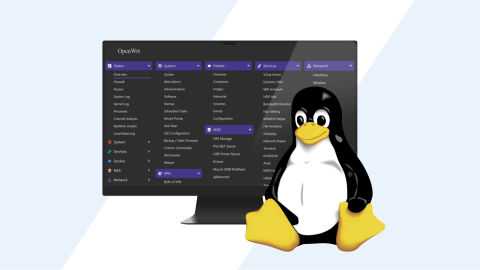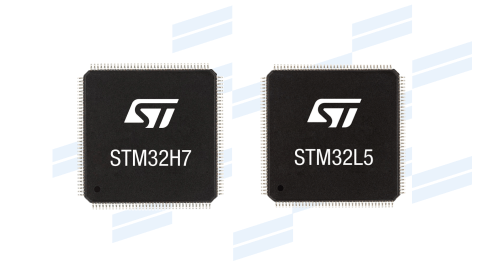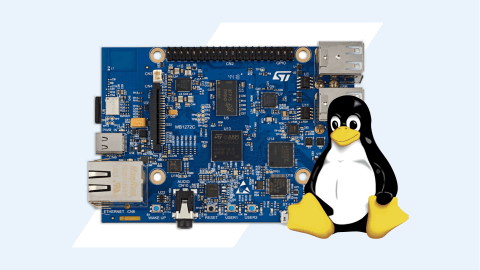The FPGA market has been rapidly growing as more and more global enterprises have started to use FPGAs for building highly functional and complex embedded systems. FPGA programming applies to developing embedded solutions for healthcare, aerospace, automotive, consumer electronics, energy, and other fields.
FPGA popularity is one of the reasons we have interviewed our engineers on this topic and want to share our results here.
What is FPGA programming: brief overview
FPGA is a programmable gate array comprising interconnected logic elements within a chip. Each element can be configured and connected according to the action it must complete. A significant difference and benefit of an FPGA compared to an MCU and an MPU is its flexibility, meaning that the logic elements inside an FPGA could be interconnected to create specific functionality. The chip configuration could be simply changed to add new functionality and expand system capabilities far more than it was designed for.
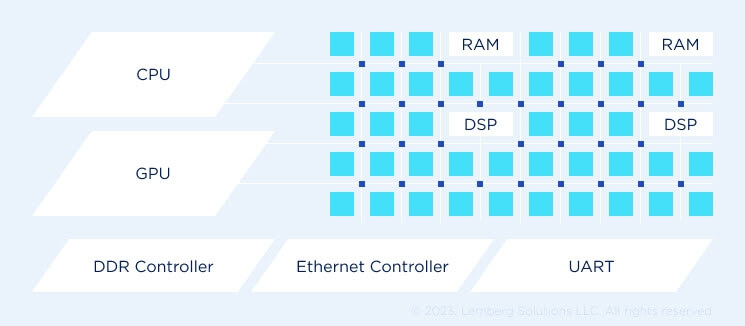
Typically, you need FPGA programming for high-compute embedded systems, where a high speed and performance of system operations are crucial. FPGAs are mainly used in medical & scientific devices, image and video processing, Telecom and Datacom, aerospace and defense, server and cloud.
The four directing market players producing FPGA integrated circuits are Intel, Xilinx, Lattice, and Microchip, where Xilinx has the highest quality and most sales worldwide. FPGA vendors are similar, and the best solution will mostly depend on your business needs, like chip stock, target BOM cost, and design specifications.
FPGA architecture: essentials
The architecture of FPGA chips depends on the provider, but each chip has some essential elements, including:
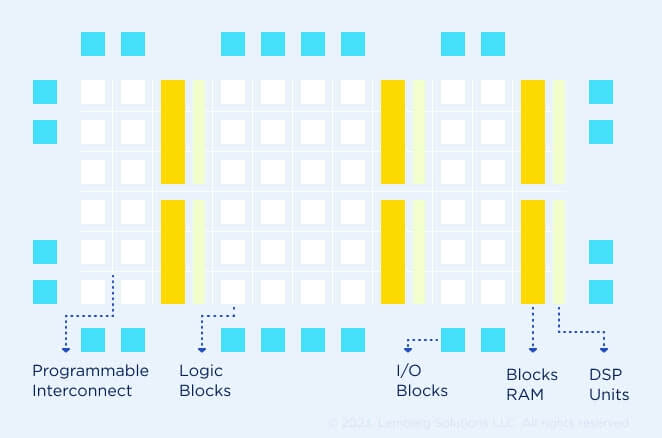
- Logic blocks - these configurable components form the logic functions within a chip based on FPGA design and consist of RAMs, LUTs, multipliers, and routers.
- Input/Output (I/O) blocks - these blocks show the connection between external digital circuits and FPGA building blocks.
- Interconnections - these elements form connections between input and output blocks, also called logic block routing components.
Also, an FPGA can contain hardware processing cores, high-speed transceivers, and other useful peripheries.
It is worth noting that FPGA provides no pre-configured architecture. The device downloads its configuration during startup. Upon loading the configuration into the device, all interconnections between the logic blocks are set, and the FPGA is ready to execute the designed functions.
FPGA vs microcontroller
FPGA and microcontroller are the processing system components within the embedded system, where the selection of needed elements depends on the project requirements.
FPGA and microcontrollers are two types of digital circuit components with different architectures and functionality.
A microcontroller is a small computer with a processor, memory, and I/O peripherals placed on an integrated digital circuit. It is mainly used for creating embedded systems of various types and purposes, for instance, consumer electronics products, automotive solutions, and medical devices. The task of a microcontroller is to perform a particular function within an embedded system.
The major difference between FPGA and the microcontroller is FPGA`s flexible functionality. FPGA is an integrated digital circuit programmed to perform specific functions by users. Its logic blocks can be interconnected to build custom digital circuits. Embedded engineers can reconfigure FPGA to change the device functionality after installation.
As we figured out the core components each FPGA-based chip contains, we would like to explore how all these components are actually placed and interconnected within a single gate array.
3 key steps of FPGA design flow
The FPGA programming design flow outlines the implementation process of programmable logic blocks on a chip itself. So let's dive into the stages of this process and discover what each entails.
- Design entry
It is pivotal to correctly design building blocks and register-transfer logic to ensure the proper logic and digital circuits interconnection of an FPGA. That is why the first step in the FPGA design flow is documenting the design ideas of the future solution to validate them and check their feasibility. The FPGA system design utilizes HDLs (hardware description languages) or FPGA programming languages, particularly Verilog and VHDL.
- Design synthesis
FPGA design synthesis entails converting HDL design into netlists consisting of logic gates. It uses synthesis tools like XST, Vivado, Quartus II, or IspLever, which analyze HDL input data and provide output data to logic elements. The primary condition of HDL design implementation is its high speed. So if the timing requirements are not met, the synthesis tool works on logic gates optimization.
- Design implementation
The FPGA design implementation consists of two steps - placement and routing. Each netlist file contains logic elements with a set of timing constraints that must correlate with the available resources in FPGA design. So the placer is accountable for all netlist files to be properly located on the chip. At the same time, the router must connect these placed netlists with one another within the set timing requirements.
Benefits of FPGA programming for embedded systems
FPGA is a fully configurable chip that embedded engineers can redesign upon customers` request. This approach makes the embedded system development faster and the final product highly functional. Despite FPGA being a rather costly solution, its price is incomparable to its advantages. Let's take a closer look at the top reasons for considering FPGA system design.
Reconfigurable elements
Application-specific integrated circuits (ASICs) are configured and implemented to chips once. It means there is no other way to upgrade them than rework the chip from scratch. On the other hand, the FPGA programming approach allows engineers to add or change the installed logic elements and functions. FPGA embedded system design can be reconfigured after installation.
Parallel functionality
FPGAs are mostly used for systems to simultaneously process vast volumes of data. Due to parallel functionality, the FPGA system design provides a high data processing speed as different parts of FPGA can take and analyze the pieces of data.
Real-time data processing
FPGA design is used for high-speed computing tasks microcontrollers or microprocessors cannot handle appropriately. Due to its flexibility and adjustment to the required hardware design, the FPGA-programmed chip can process data of any volume and complexity in real time.
Single-chip solution
Despite being more expensive than microcontrollers, a single FPGA chip can be programmed with all required options to make the embedded system highly operational. In addition, you can adjust or add the configuration you need to upgrade your device functionality.
The list of advantages of FPGA programming can go on as it makes hardware development much faster and more efficient and therefore requires fewer resources. These FPGA benefits made it widely used in a whole range of spheres we will discuss below.
FPGA programming uses, and applications
FPGA programming is in high demand for designing embedded systems in all industries where IP protection plays a significant role, such as military, energy, automotive, and other fields. It is used for solutions that perform complex computing tasks and require high loading speed and real-time data processing. Here are some industry-related applications of the FPGA approach.
Energy
Owing to our broad expertise in the energy industry at Lemberg Solutions, we know the growing need for optimizing energy consumption while keeping the energy data loading speed and security high within smart grids. Implementing FPGA chips keeps energy consumption low by enabling real-time monitoring of the smart grid consumption and defining peak hours. That is how you outline the optimal network power and performance for smart grids.
Automotive
Using FPGA programming languages and tools, our engineers can develop and integrate automotive systems like vehicle safety, infotainment, ADAS, and autonomous driving systems. FPGAs are a flexible solution that enables real-time data analysis and decision-making and can be easily integrated into any vehicle type and automotive environment.
Healthcare
FPGA design has many applications in the healthcare industry, from medical imaging analysis to the design of implanted medical devices. Thanks to real-time monitoring capabilities, devices integrated with FPGA chips provide the current vital signs status. Moreover, you can easily add required functions to a single chip, making the medical device more effective.
Computer vision
As FPGA works in parallel, it is an excellent choice for computer vision systems like object recognition, image and video processing, real-time object tracking, and other applications. Since the mentioned systems require high processing speed and minimal latency, FPGA programming is a perfect match.
Final thoughts
The Lemberg Solutions team can help you design, build, and implement an FPGA-based embedded system, being knowledgeable in FPGA expertise and tools. Our engineers can also select and optimize the embedded platform for various IP cores and develop a System on a Chip (SoC). We will consider all your project requirements, including power consumption, required tools, processing complexity, and budget, to deliver a powerful FPGA system that meets your ongoing business needs.

FAQs
What do FPGA development services at Lemberg Solutions include?
Our engineers keep expanding our FPGA expertise and the range of FPGA programming services we can provide. Among the FPGA development services we offer at Lemberg Solutions are FPGA architecture and design, IP core selection and platform optimization, FPGA design optimization (timing closure, latency, power, resources utilization, gate count), System on a Chip (SoC) software development, development of DSP algorithms in Matlab Simulink, and FPGA based AI and sensor fusion solutions.
What is the key difference between FPGA programming and software programming?
FPGA programming entails the creation of customizable digital circuits to execute specific tasks by hardware. Software programming involves writing code for a system that runs on computers and other devices.
What languages are used to program FPGAs?
FPGA programming entails using programming language and hardware description tools. The FPGA hardware description languages list includes VHDL, Verilog, and SystemVerilog.

